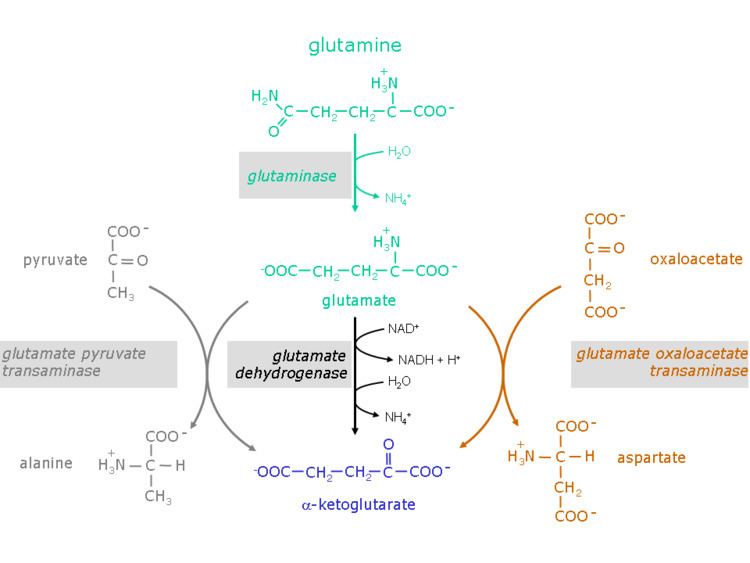 | ||
Glutaminolysis (glutamine + -lysis) is a series of biochemical reactions by which the amino acid glutamine is lysed to glutamate, aspartate, CO2, pyruvate, lactate, alanine and citrate.
Contents
- The glutaminolytic pathway
- Reaction steps from glutamine to ketoglutarate
- Recruited reaction steps of the citric acid cycle and malate aspartate shuttle
- Reaction steps from malate to pyruvate and lactate
- Intracellular compartmentalization of the glutaminolytic pathway
- Glutaminolysis an important energy source in tumor cells
- Energy efficacy of glutaminolysis in tumor cells
- Advantages of glutaminolysis in tumor cells
- References
The glutaminolytic pathway
Glutaminolysis partially recruits reaction steps from the citric acid cycle and the malate-aspartate shuttle.
Reaction steps from glutamine to α-ketoglutarate
The conversion of the amino acid glutamine to α-ketoglutarate takes place in two reaction steps:
1. Hydrolysis of the amino group of glutamine yielding glutamate and ammonium. Catalyzing enzyme: glutaminase (EC 3.5.1.2)
2. Glutamate can be excreted or can be further metabolized to α-ketoglutarate.
For the conversion of glutamate to α-ketoglutarate three different reactions are possible:
Catalyzing enzymes:
Recruited reaction steps of the citric acid cycle and malate aspartate shuttle
catalyzing enzyme: α-ketoglutarate dehydrogenase complex
catalyzing enzyme: succinyl-CoA-synthetase, EC 6.2.1.4
catalyzing enzyme: succinate dehydrogenase, EC 1.3.5.1
catalyzing enzyme: fumarase, EC 4.2.1.2
catalyzing enzyme: malate dehydrogenase, EC 1.1.1.37 (component of the malate aspartate shuttle)
catalyzing enzyme: citrate synthase, EC 2.3.3.1
Reaction steps from malate to pyruvate and lactate
The conversion of malate to pyruvate and lactate is catalyzed by
according to the following equations:
Intracellular compartmentalization of the glutaminolytic pathway
The reactions of the glutaminolytic pathway take place partly in the mitochondria and to some extent in the cytosol (compare the metabolic scheme of the glutaminolytic pathway).
Glutaminolysis: an important energy source in tumor cells
Glutaminolysis takes place in all proliferating cells, such as lymphocytes, thymocytes, colonocytes, adipocytes and especially in tumor cells. In tumor cells the citric acid cycle is truncated due to an inhibition of the enzyme aconitase (EC 4.2.1.3) by high concentrations of reactive oxygen species (ROS) Aconitase catalyzes the conversion of citrate to isocitrate. On the other hand, tumor cells over express phosphate dependent glutaminase and NAD(P)-dependent malate decarboxylase, which in combination with the remaining reaction steps of the citric acid cycle from α-ketoglutarate to citrate impart the possibility of a new energy producing pathway, the degradation of the amino acid glutamine to glutamate, aspartate, pyruvate CO2, lactate and citrate.
Besides glycolysis in tumor cells glutaminolysis is another main pillar for energy production. High extracellular glutamine concentrations stimulate tumor growth and are essential for cell transformation. On the other hand, a reduction of glutamine correlates with phenotypical and functional differentiation of the cells.
Energy efficacy of glutaminolysis in tumor cells
Due to low glutamate dehydrogenase and glutamate pyruvate transaminase activities, in tumor cells the conversion of glutamate to alpha-ketoglutarate mainly takes place via glutamate oxaloacetate transaminase.
